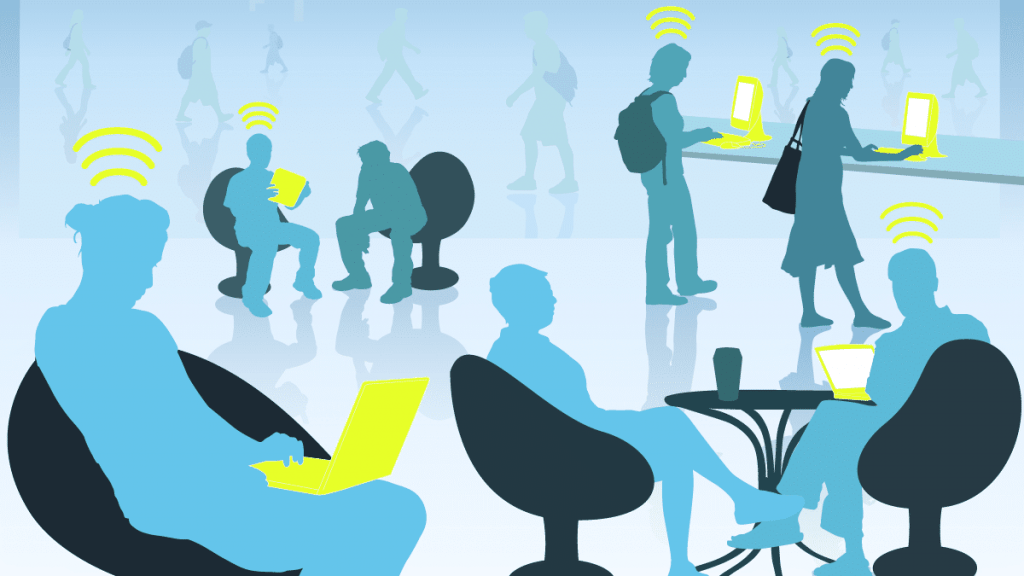There are several advantages to having a personal wireless WiFi network in your home, the main one, of course, is that you can move about your home freely while remaining connected to the internet.
Being able to receive a connection to the internet within your home, wherever you choose to use it, is a great advantage when considering the myriad of technical possibilities available to the public in this age of internet connectability. However, as with anything else, you do need to make sure your information is protected and secure at all times to keep it from falling into the hands of thieves. Of course, you do not want anyone stealing your internet connection, which you have to pay for monthly. However, there is a more sinister reason people will hack into your wifi network. I like to have a little fun with my home WiFi network’s ID. Since everyone will see it when their device lists all of the available WiFi networks within the area, I usually name mine something like “FBI Surveillance Van #5” that one is always good for a chuckle. Plug one end of the Ethernet cable into your PC’s Ethernet port, plug the other end of the cable into your router. If your computer does not have an Ethernet port, you will need to use a USB-to-Ethernet adapter. The Ethernet cable looks like an oversized phone cable. In this article, I will provide you with well-documented options to keep your home’s WiFi network router as secure as possible. Your WiFi network’s security is critical, and I will help you protect your valuable personal information.
I usually name mine something like “FBI Surveillance Van #5” that one is always good for a chuckle. Plug one end of the Ethernet cable into your PC’s Ethernet port, plug the other end of the cable into your router. If your computer does not have an Ethernet port, you will need to use a USB-to-Ethernet adapter. The Ethernet cable looks like an oversized phone cable. In this article, I will provide you with well-documented options to keep your home’s WiFi network router as secure as possible. Your WiFi network’s security is critical, and I will help you protect your valuable personal information.
Router Web Portal
Your home WiFi router will come with software, known as firmware. The router’s firmware can be found on the manufacturer’s website, which is provided with your router. From the router’s firmware website you will be able to adjust or change several different settings including: Change the name of your network.
- Change the WiFi network’s password.
- The security level of the WiFi network.
- Create a guest network.
- Setting up or changing a variety of different options.
What to do if You Forget Your Router’s Login Information
In the unfortunate situation, you forget your WiFi network’s username and password for logging into the router. Most routers provide a default of admin and a default password of password. You can give this a shot if you do wind up forgetting your login information. If this option does not work on your router, then there is usually password-recovery feature. If this is the case with your router, you will be given a recovery option on the sign in page. In the unlikely event neither of these options work, you can run a search of the manufacturer’s name along with the phrase “default username and password.”
Resetting the Router’s Complete Settings
In the event that this does not work either, you still have one more final option. The manufacturer of your router provides you with one final out. This option is to reset all of the router’s settings. To reset the router’s settings, locate the recessed button (usually red), stick a pin or paperclip into the hole and hold it there for a few seconds.  When this is done, you will need to fill it. When this step is complete, you should then be able to log into your router with the default username and password. After the system reset is complete, and you have made sure everything is back to when you first bought the router, before you do anything else, change the login information by adding your own choice of username and password. Your router will, most likely, have a reset button that is recessed into the device. Router manufacturers add a recessed button, that can only be accessed by using a pin or paperclip, so the router does not ever have all of the settings reset by accident. You want to keep the option of resetting your entire system and all of the WiFi network’s settings as a last resort for the simple fact you will then need to reset all of your preferred settings all over again. This may not see that big of an issue to most people; however, it is just one more thing you have completely redone.
When this is done, you will need to fill it. When this step is complete, you should then be able to log into your router with the default username and password. After the system reset is complete, and you have made sure everything is back to when you first bought the router, before you do anything else, change the login information by adding your own choice of username and password. Your router will, most likely, have a reset button that is recessed into the device. Router manufacturers add a recessed button, that can only be accessed by using a pin or paperclip, so the router does not ever have all of the settings reset by accident. You want to keep the option of resetting your entire system and all of the WiFi network’s settings as a last resort for the simple fact you will then need to reset all of your preferred settings all over again. This may not see that big of an issue to most people; however, it is just one more thing you have completely redone.
The Router’s Web Address
Router manufacturers usually provide a web address for all of their routers. Some manufacturers, including Belkin, only require you to type the word “router” into the address bar to be taken to the router’s settings page. However, most router manufacturers will need you to use a standard web address to get to the settings dashboard. Still, other, more current WiFi routers will provide you with a QR code in addition to a URL, which is meant to help you better, manage your router’s settings, including the password from a smartphone or a tablet.
Factory Default Username and Password
Most new routers will come with a predetermined and set username and password already in place. Most of the time, the defaults are as simple as “admin” for the username and the password being “admin,” “default” “1234” or even “password.” If one of these standard passwords does not work, you will find a list of default passwords used by your router’s manufacturer on the device’s product support pages or even located on sites like RouterPasswords.com or Router-Reset.com.
The Importance of Password Strength
How secure is your WiFi network’s password? This is where most people set themselves up for easy hacking by using weak passwords. You want to come up with a password that will be extremely difficult, if not impossible for someone to hack into your network. Most people misunderstand the importance of strong passwords because they are of the mindset that the only reason someone would want to hack into their home’s WiFi network is so they can use their internet connection for free. Thinking that the only reason someone would hack your home WiFi connection is to receive an internet connection without paying for it can be a very costly error on their part. The main reason people will hack into a home network is to steal their important personal information so they can steal their identity, gain access to their financial information and reak all sorts of havoc for financial gain. The strength of your password can be similar to the locks you have in your home. You definitely would not expect weak, shabby locks on the doors of your home to keep burglars out. Just like you would never consider leaving your house unlocked altogether. This is why it is so important to think up a strong password for your home WiFi network. Short passwords are much more vulnerable than longer passwords; this is pretty much a given. Password strength is measured by how easy it is to hack into a network by either guessing what the password is or using brute force attacks to gain access to access.
Creating a Password
Creating a password for your WiFi network can be done in two different ways, either by using software that will choose your password for you or by creating your own password. Most people choose passwords themselves. When people choose their own passwords, they usually do so by using some combination of letters and numbers that are easy for them to remember. Most people choose a password that is easy for them to remember, which makes it easier for them to be targeted by hackers. The password to your home WiFi network is one of the essential passwords you will ever create. This is because, if a hacker gains access to your home WiFi network, they will be able to gain access to most all information that transverses that network.
Make Sure Your Router is Upgraded
There are different steps to securing your WiFi network. One of the first steps to making your WiFi as secure as it can be is to make sure your router is up to date with upgrades. Visit the site of the manufacturer of your router and make sure there are no updates you haven’t already downloaded. In comparison to other software, routers do not usually require multiple upgrades on a regular basis. If the manufacturer of your router has released an update since you first purchased the router, you will need to make those updates. Another consideration while updating your router, is to update one of the helpful third-party firmware focused on WiFi network routers including DD-WRT or Tomato. Third-party firm unlocks all different sorts of beneficial options including easier and focused control over security features.
Router Third-Party Firmware
Router third-party firmware is software embedded within your router, which provides network protocols, security embedded, and administrative controls. When you install a router, you access the firmware. This router’s firmware is set on a “read-only” memory chip inside the router, which is set to “read-only.” To set up security and administrative options. It is possible for the user to upgrade the firmware by the user.
Changing Your SSID
A router’s SSID is just a simple term for a network’s name. When initially setting up your home’s WiFi network router you give it a name that will distinguish it from the other networks within your immediate area. When your router is shipped from the factory the manufacturer provides it with a generic SSID; this name is usually something simple like “Wireless” or in some cases the manufacturer will provide their name as the one for the network like “Belkin.” There is nothing wrong with leaving the name that is already provided. However, if you live in a densely populated area, like a city neighborhood, it makes sense to change the default name to something different in order to distinguish it from the other home WiFi networks around you. Some users who live in densely populated cities will name their routers something like their address like “Apt3A” which distinguishes their address. It is true that the most important aspect of a home WiFi network is its password. However, it is not a good idea to name it with your address because this helps the hacker to zero in on whose network it is. This knowledge can give the hacker one piece to the puzzle of cracking your password; they are then able to try specific password options to the hack. These options will then include the occupant’s birthdate etc to try out. However, on the other hand, changing the router’s name can help you to know which network is your own. A much better option is to give the network a name that is easy for you to remember (nickname, etc.).
Media Access Control Addresses
Media Access Control Addresses, or MAC for short, is the unique ID which is assigned to every network interface you have. The MAC address for devices is printed on a label affixed to the device. Besides locating it affixed to the device, one of the easiest ways to identify the MAC address on your router after you have upgraded your encryption and logged all of your devices back in. As I have already stated, changing your router’s ID is just one more step for a potential hacker to have to accomplish before they even get the “key” to the lock on your home’s WiFi network.
Besides locating it affixed to the device, one of the easiest ways to identify the MAC address on your router after you have upgraded your encryption and logged all of your devices back in. As I have already stated, changing your router’s ID is just one more step for a potential hacker to have to accomplish before they even get the “key” to the lock on your home’s WiFi network.
Adjust the Power Output of Your Router
Another option to increase the security of your home’s WiFi network router is to adjust the power, or range, of the router’s output so that a potential hacker would need to be within the router’s range to even begin to hack it. For example, if you live in an apartment or even a home within a neighborhood, if you dial down the output, the potential hacker would need to be extremely close to your home even to begin to hack it. This option is available to people who are using a custom firmware that allows you to make this adjustment. The ability to be able to dial down the output of your router allows you to ensure the coverage of your WiFi does not leave the immediate area of your home. The ability to adjust the output of your WiFi signal also means if you choose to receive an internet connection outside of your home if you prefer, and only when you choose to have it as in the case or sitting outside. In conclusion, the importance of carefully thinking through and applying the best security measures you possibly can on your home’s WiFi network router cannot be described strongly enough. There are a lot more important reasons for securing your WiFi network than just keeping our neighbors from scamming internet from the connection you pay for. The most important reason for a secure WiFi connection is to keep potential hackers from stealing your identity and, along with it, the ability to access your most important accounts including:
- Banking information
- Credit card information
- All of your IDs and passwords to your financial accounts
- Your purchasing information and so much more
This level of intrusion into your financial accounts requires that you take advantage of using the most up-to-date security measures you can find. The password for your WiFi network should be considered as important as the master key to your home and it should be considered as such.






